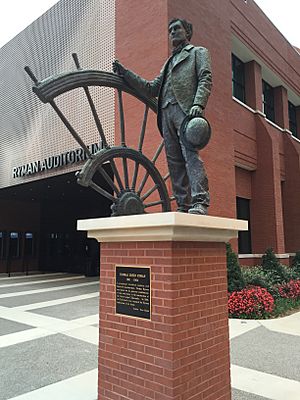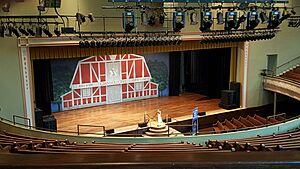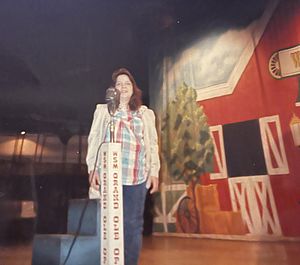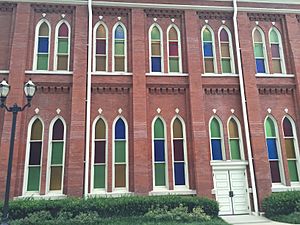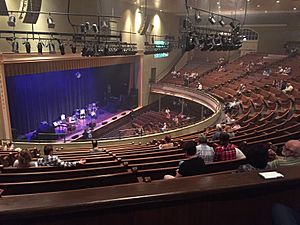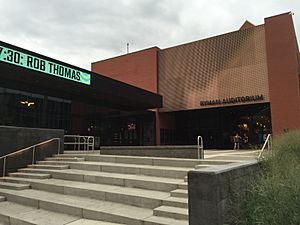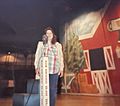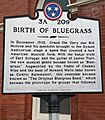Ryman Auditorium facts for kids
|
"The Mother Church of Country Music"
"The Birthplace of Bluegrass" "The Carnegie Hall of the South" "The Ryman" |
|
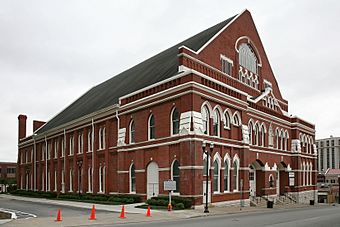
Ryman Auditorium, facing Nashville's Rep. John Lewis Way North
|
|
| Former names | Union Gospel Tabernacle (1892–1904) Grand Ole Opry House (1963–1974) |
|---|---|
| Location | 116 Rep. John Lewis Way North Nashville, Tennessee 37219 |
| Coordinates | 36°9′40.6″N 86°46′42.6″W / 36.161278°N 86.778500°W |
| Owner | Ryman Hospitality Properties, Inc. |
| Type | Concert hall Theatre Broadcast venue |
| Seating type | Pews |
| Capacity | 2,362 (1994–present) |
| Construction | |
| Built | 1885–1892 |
| Opened | 1892 |
| Renovated | 1901, 1952, 1989, 1994, 2010 |
| Expanded | 1897, 1994, 2015 |
| Construction cost | US$100,000 (equivalent to $3,257,037 in 2022) |
The Ryman Auditorium is a famous place for live shows and a museum in Nashville, Tennessee. It has 2,362 seats and is known as "The Mother Church of Country Music." From 1943 to 1974, it was the home of the Grand Ole Opry, a very popular country music radio show.
The Ryman is owned by Ryman Hospitality Properties, Inc. It was added to the National Register of Historic Places in 1971. In 2001, it became a National Historic Landmark because it played a huge part in making country music popular. In 2022, the Ryman was also named a Rock & Roll Hall of Fame Landmark.
Contents
History of the Ryman Auditorium
Building the Union Gospel Tabernacle
The Ryman Auditorium first opened in 1892 as the Union Gospel Tabernacle. A Nashville businessman named Thomas Ryman (1843–1904) led its construction. He wanted to build a large meeting place for a famous preacher, Samuel Porter Jones.
Ryman went to one of Jones's outdoor meetings in 1885. He planned to cause trouble, but instead, he was deeply moved and decided to build a tabernacle. He wanted people in Nashville to have a big indoor place for these meetings.
It took seven years to build and cost about $100,000 in 1892. Jones held his first meeting there on May 25, 1890. At that time, only the foundation and lower walls were finished.
The building was designed by architect Hugh Cathcart Thompson. It cost more than expected, opening with a $20,000 debt. Jones wanted to name the building after Ryman, but Ryman said no many times.
When Ryman passed away in 1904, his memorial service was held at the tabernacle. During the service, Jones suggested renaming the building Ryman Auditorium. Everyone there agreed. Jones himself passed away less than two years later in 1906.
The building was planned to have a balcony, but there wasn't enough money to finish it at first. The balcony was finally built in 1897 with money from a group called the United Confederate Veterans. Because of this, the balcony was once called the Confederate Gallery. In 2017, the old plaque was replaced with one that says "1892 Ryman Auditorium."
When the balcony was finished, the Ryman could hold up to 6,000 people. A stage was added in 1901, which reduced the seating to just over 3,000.
Lula C. Naff's Leadership
Even though the Ryman was built as a church, it was often rented out for other events. This helped pay off its debts and keep it open. In 1904, Lula C. Naff, a working mother, started booking concerts and other shows at the Ryman in her free time.
By 1914, she made this her full-time job. By 1920, she became the Ryman's official manager. She used the name "L.C. Naff" to avoid problems as a female leader in a male-dominated business.
Naff was known for fighting against local groups that tried to ban shows they thought were too risky. In 1939, she won an important court case. The court said the law creating the censors was not valid.
Naff brought many famous performers to the Ryman. This made Nashville known as a cultural center. Some famous people who performed there included Harry Houdini in 1924, Will Rogers in 1925, and John Philip Sousa. U.S. presidents Theodore Roosevelt and William Howard Taft also gave talks there. Italian opera singer Enrico Caruso performed in 1919. The Ryman earned the nickname "The Carnegie Hall of the South."
The first event to sell out the Ryman was a talk by Helen Keller and Anne Sullivan Macy in 1913. Naff also supported diversity. The Ryman was a regular place for the Fisk Jubilee Singers from Fisk University, a historically Black college.
Even though state laws required audiences to be separated by race, photos show that Ryman audiences were often mixed. Naff retired in 1955 and passed away in 1960.
The Grand Ole Opry Years
The Grand Ole Opry was a local country music radio show that started in 1925. It became very popular in Nashville. The show was broadcast on radio station WSM and could be heard in many states.
At first, people came to the WSM studio to watch the show live. When too many people showed up, the Opry moved to bigger places. In 1943, the Grand Ole Opry started broadcasting from the Ryman. It stayed there every week for almost 31 years. Every show sold out, and many fans couldn't get in.
During its time at the Ryman, the Opry featured all the big country music stars. It became famous worldwide. Because it was a church building that became home to country music, the Ryman earned its nickname, "The Mother Church of Country Music."
The Ryman wasn't built as a performance hall, so it didn't have much backstage space. There was only one dressing room for men, and women had to use a small restroom. Performers often waited in the narrow hallways or in the alley behind the building. Many would even go across the alley to places like Tootsie's Orchid Lounge. This made the bars on Nashville's Lower Broadway even more popular.
Many famous musicians performed at the Ryman during the Opry years. These included Marian Anderson in 1932, Bill Monroe in 1945, Hank Williams in 1949, Elvis in 1954, Johnny Cash in 1956, and Patsy Cline in 1960.
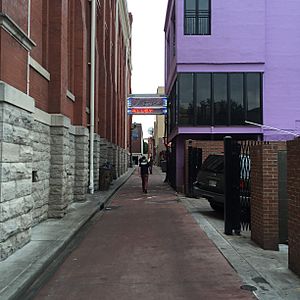
Before 1963, the Ryman Auditorium didn't have one owner. It was run by a board of directors. Then, WSM, Inc., bought the building for $207,500. WSM renamed it the Grand Ole Opry House, but many people still called it the Ryman.
WSM made some small improvements in 1966. However, they soon planned to move the Opry to a new place. The Ryman was getting old, didn't have air conditioning, and its neighborhood was changing. Also, the show's popularity meant too many people wanted to see it.
In 1969, plans were announced for a new, bigger auditorium. This new place would be more comfortable for audiences and performers. It would also have better facilities for radio and TV broadcasts.
The company bought a large piece of land a few miles away. The new Opry theater became the main part of a huge entertainment complex called Opryland USA. This included the Opryland theme park and the Opryland Hotel.
The new Opry theater opened on March 16, 1974. The last Opry show at the Ryman was the night before, on March 15. It was a very emotional night. To keep a connection to the Ryman, a large circle was cut from the Ryman stage floor. This circle was placed in the center of the new Opry stage. The new Opry House also had pew seating, like the Ryman, but with cushions.
Eventually, the building downtown went back to being called Ryman Auditorium. This helped people tell it apart from the new Grand Ole Opry House.
Saving the Ryman from Demolition
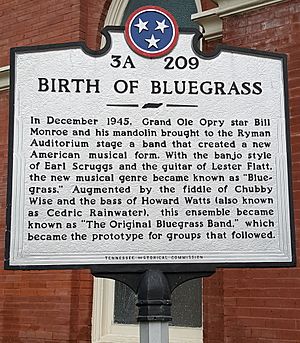
When the plans for Opryland USA were announced, WSM president Irving Waugh also said they wanted to tear down the Ryman. He planned to use its materials to build a small chapel at the theme park. A theater expert said the Ryman was not worth saving and should be replaced.
But many people, including famous musicians, strongly disagreed. An architecture critic from The New York Times criticized the decision.
However, Roy Acuff, a big star of the Opry, wanted the Ryman torn down. He said he had many bad memories of sweating on the stage. He also hated the small dressing rooms. Acuff even bought a nearby building just to have a bigger dressing room. Today, there are statues of Acuff and Minnie Pearl in the Ryman lobby.
Groups that wanted to save historic buildings argued that WSM was exaggerating the Ryman's poor condition. They said WSM was worried that people's love for the old building would hurt business at the new Opry House. These groups highlighted the Ryman's importance to religious history.
The building was officially added to the National Register of Historic Places in 1971. In 1974, U.S. Senators from Tennessee and government officials asked WSM to save the building. The company decided to put off the decision. The Ryman was saved from being torn down, but no major work was done to fix it up right away.
Quiet Years
After the Opry moved out, the Ryman didn't attract many new performers. It was mostly empty and getting worse for almost 20 years. The area around it also became run-down.
Even though it was in bad shape and had few shows, the Ryman Auditorium never officially closed. It remained a place for people to visit and learn about its history.
In 1983, a company called Gaylord Broadcasting Company bought WSM and the Opryland properties. The Ryman Auditorium was included in this sale. The company's chief executive, Ed Gaylord, liked the Opry and its stars. His appreciation for the Ryman's history helped keep it safe.
In 1986, for the Grand Ole Opry's 60th anniversary, CBS aired a special show. It featured some Opry legends performing at the Ryman. Even when the auditorium was quiet, movies were filmed there. These included Coal Miner's Daughter (1980) and Sweet Dreams (1985).
Bringing the Ryman Back to Life
In 1989, Opryland USA, Inc. started to make the Ryman's outside look better. They put on a new roof, replaced broken windows, and fixed bricks and wood. However, the inside of the building was mostly left as it was.
From April 30 to May 2, 1991, Emmylou Harris and the Nash Ramblers played three acoustic concerts at the old building. For safety, no one was allowed to sit under the balcony. Only about 200 people could attend. Some of these recordings were released on an album called At the Ryman. This album won a Grammy Award in 1993. These concerts and the album's success helped create new interest in bringing the Ryman back as an active music venue.
On May 18, 1992, the Ryman hosted a concert and play to celebrate its 100th birthday. In October 1992, Gaylord Entertainment announced plans to completely renovate the building. They wanted to add modern features for performers and audiences. This was part of a bigger plan to improve downtown Nashville.
In September 1993, major renovations began. The building got new systems, including air conditioning for the first time. The Ryman's original wooden pews were taken out, fixed up, and put back. Parts of the U-shaped balcony were removed. New backstage areas were built inside the original building.
A new addition was built on the east side of the auditorium. This addition included a lobby, restrooms, food stands, offices, and a grand staircase to the balcony. With this change, the Ryman's main entrance moved from the west side to the east side. An outdoor entrance area was also added, with a large statue of Thomas Ryman.
The first performance at the newly renovated Ryman was a broadcast of Garrison Keillor's A Prairie Home Companion on June 4, 1994. After that, the Ryman hosted a long run of the musical Always... Patsy Cline, about the life of the legendary singer Patsy Cline.
The Opry Comes Back
On October 18, 1998, the Opry held a special show at Ryman Auditorium. This was the first time it had been back since March 15, 1974. Fans, performers, and managers loved the show. So, they decided to host regular Opry shows there on January 15 and 16, 1999.
Starting in November 1999, the Opry was performed at Ryman Auditorium for three months each year. This allowed them to avoid construction noise from the Opry Mills shopping mall being built next to the Grand Ole Opry House. The Opry returned to the Ryman every year for its November, December, and January shows until 2019–20. This helped the show remember its history and use a smaller venue during the slower tourist season. It also freed up the Grand Ole Opry House for holiday events.
The Ryman also served as the main venue for the Opry in the summer of 2010. This was when the Grand Ole Opry House was being repaired after a big flood.
The yearly winter season at the Ryman was stopped in 2020 because of the COVID-19 pandemic. The Opry performed shorter shows for broadcast in an empty Grand Ole Opry House. The winter Ryman shows did not return in 2021, even though attendance rules were lifted. Opry shows returned to the Ryman for one month in January 2023, and for three nights in January 2024. These shows are called Opry at the Ryman.
The Ryman Today
Gaylord Entertainment Company, which owned the Ryman since 1983, changed its name to Ryman Hospitality Properties, Inc. in 2012. The Ryman Auditorium is now managed by Opry Entertainment Group. The Ryman's renovation, along with other new attractions, helped make downtown Nashville a popular place for tourists and locals in the mid-1990s.
Since then, the Ryman has become one of the most respected performance venues in Nashville. Performers often praise the Ryman Auditorium's acoustics, saying they are among the best in the world.
The Ryman was not harmed by the 2010 Tennessee floods or the 2020 Nashville bombing. Both events caused major damage to other parts of downtown.
In January 2012, plans were announced to replace the Ryman's stage. The new stage floor was made of medium-brown Brazilian teak. It kept an 18-inch edge of the old stage's wood at the front. The stage's original support beams were made stronger with concrete foundations. This helped triple the stage's weight capacity, making sure it could be used for many years.
In 2015, the Ryman had another $14 million renovation and expansion. Much of the 1994 addition was updated. The original building received only small touch-ups and stayed open during construction. The renovation added more lobby space, bigger restrooms, more food stands, and a retail shop. A new quick-service restaurant called "Cafe Lula" was added, named after Lula C. Naff. This cafe closed in 2020 due to the COVID-19 pandemic. In 2023, an expanded retail shop selling Ryman items opened in its place.
Before the pandemic, Opry Entertainment Group held regular shows at the Ryman all year. Besides the Opry at the Ryman shows in winter, the auditorium hosted Opry Country Classics in spring and autumn, and Bluegrass Nights at the Ryman in summer. Due to concerts being rescheduled after the pandemic, some of these shows were moved to the Grand Ole Opry House in 2021.
When COVID-19 hit Nashville, live music at the Ryman stopped for a short time. Then, the venue started a livestream concert series called "Live at the Ryman" in August 2020. Artists like For King & Country and Old Crow Medicine Show performed for online audiences. Bluegrass Nights returned to the Ryman in 2021, and Opry at the Ryman returned in January 2023.
The Ryman has welcomed many different types of performers. Recently, Wu-Tang Clan was the Ryman's first hip-hop headliner. The Ryman also hosted its first comedy residency in August 2022 with comedian John Mulaney.
In 2018, Architectural Digest magazine named the Ryman the most iconic building in Tennessee. The Ryman has been named Pollstar's Theater of the Year 13 times. It was also named the Academy of Country Music's Theater of the Year in 2022. Many music award shows have taken place on the Ryman stage.
On May 26, 2022, the Ryman officially became a Rock & Roll Hall of Fame Landmark. Later that year, the Rock & Roll Hall of Fame worked with the Ryman to create a tour feature about rock history in Nashville. "Rock Hall at the Ryman" opened on November 2, 2022. It includes items from artists like Elvis Presley, James Brown, and Dolly Parton.
The Ryman has also been a gathering place for the memorial services of many important country music figures. These include Tammy Wynette, Johnny Cash, and Naomi Judd.
Museum and Tours
The Ryman is open for tours during the day when there are no shows. Guided tours let you see backstage areas. Self-guided tours feature exhibits in cases throughout the auditorium.
Permanent exhibits include "Rock Hall At The Ryman," which shows the venue's importance in rock music. There's also the Soul of Nashville, a short film that uses holographic technology. In this film, an actress plays Lula C. Naff and tells the Ryman's history. It also features a song performed by Darius Rucker, Sheryl Crow, Vince Gill, and the Fisk Jubilee Singers.
Notable Events and Performances
The Ryman hosts many types of concerts, including alternative rock, bluegrass, blues, country, classical, folk, gospel, jazz, pop, hip hop, and rock. It also hosts musical theater and stand-up comedy.
- The Ryman was home to the Grand Ole Opry from 1943 to 1974. During this time, many traditional country music artists like Dolly Parton, Loretta Lynn, Hank Williams, and Patsy Cline made their Opry debuts there.
- The Country Music Association Awards shows were held and broadcast live from the Ryman from 1968 to 1973.
- Most episodes of the ABC variety show The Johnny Cash Show were recorded at the auditorium from 1969 to 1971. The show featured Johnny Cash and other artists like Carl Perkins and the Carter Family.
- In 2005, Neil Young recorded the concert film Neil Young: Heart of Gold at the Ryman.
- In 2014, Foo Fighters performed at the Ryman as part of their Foo Fighters: Sonic Highways television series.
- On September 8, 2016, Garth Brooks performed at the Ryman for the first time in his long career.
- On June 9, 2019, Wu-Tang Clan performed the first concert made only of hip hop music at the Ryman.
- On April 4, 2021, during the COVID-19 pandemic, Carrie Underwood performed her album My Savior in a live online concert from the Ryman stage.
- In August 2022, the Ryman hosted its first comedy residency with comedian John Mulaney.
- On November 13, 2022, Lynyrd Skynyrd performed at the Ryman. This concert was the final performance for founding guitarist Gary Rossington before he passed away in March 2023.
Images for kids
-
Alley between Ryman Auditorium and the rear of Broadway "Honky Tonks", including Tootsie's Orchid Lounge
-
Tennessee Historical Commission marker outside Ryman Auditorium, signifying the site as the birthplace of Bluegrass music
See also
 In Spanish: Auditorio Ryman para niños
In Spanish: Auditorio Ryman para niños


